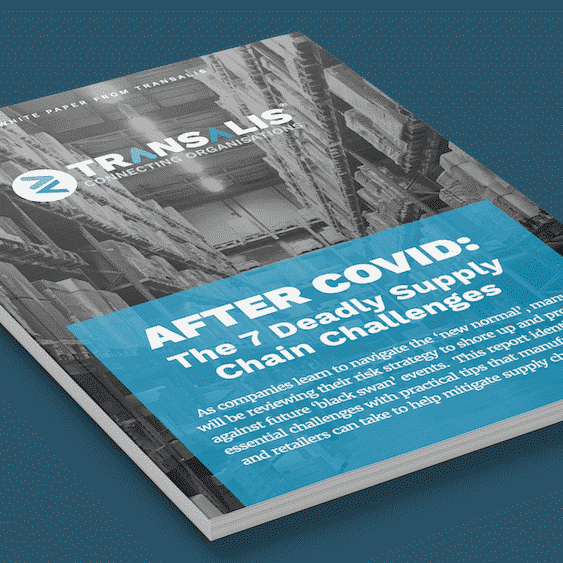Supply Chain Brain

July 10, 2020 – ‘Aniello Sabatino, Supply Chain Brain, Think Tank Article’
The COVID-19 pandemic has exposed the acute vulnerability of hitherto reliable business practices to profound economic shocks.
For industries across the world, the awkward truth is that approaches such as just-in-time and build-to-order have been found wanting.
While these methodologies traditionally help save on the cost of storage and warehousing, they are predicated on reliability of delivery. When this is less than 100% guaranteed, or breaks down altogether, the supply network struggles for continuity and has to search urgently for alternative solutions.
In other words, old processes are simply too static to maintain a dynamic workflow. So as smart companies seek to recover from their economic hit, they will apply lessons to strengthen network resilience through more robust processes.
Bigger brands, already the main adopters of automation, are likely to go ever more technological as they bid to simplify auditing and optimize cost efficiency. That could mean challenging more of their suppliers to invest in electronic solutions for ordering, shipping, invoicing and the storage of trading information.
Businesses of all kinds will be under pressure to reduce the time and cost involved in managing trade documentation. As a result, they will increasingly turn to rapid, automated systems that validate transactions and dispense with the human effort needed to check and resend.
Resetting the way trading relationships work isn’t easy, but when it comes to improving document processes, help can be found in a greater take-up of electronic data interchange (EDI).
This is a long-standing approach that enables digitized information to flow easily across a supply network. Instead of creating spreadsheets with stock and sales information, raising orders and invoices manually, and e-mailing documents that must be keyed into trading partners’ systems, EDI can automate the whole activity of sharing transaction data for electronic trading. It offers the potential to achieve time and cost savings, all necessary management requirements as we emerge from COVID-19 and plan for the future.
Here are six ways that EDI can help you overcome the main challenges involved in building supply-chain resilience:
Protecting cash flow. Many companies have struggled during the pandemic because of a lack of access to ready cash. The more agile and adaptable your processes are, the more you can protect your margins while waiting for invoices to be processed. Ideally, you need an agreed cash-flow management system governing your supplier-buyer relationship. An invoice payment application supported by EDI can take a huge amount of worry out of the situation for both suppliers and buyers.
Gathering data. To offset the risk of supply-chain disruption, you need to understand how you can improve existing risk-management procedures and planning. Some supply-chain partners may still rely on paper processes, with the attendant risk of human error rendering order, shipping and invoice data inaccurate. EDI can streamline data gathering and formatting, enabling continual end-to-end visibility of orders, shipments, invoices and payments.
Resetting thresholds. The decision on when to deploy different storage options depends on early-warning systems in inventory. That, in turn, is based on having accurate visibility across stock orders. You need to have a good understanding of the thresholds showing when there’s a shortage of stock, thus prompting the need to reorder, as well as when too much stock risks a storage crisis. The more affected by the COVID-19 disruption you have been, the more strongly you’ll have to consider recalculating stock tolerances and therefore resetting the thresholds for when action needs to be taken. The data stock and sales data shared with trading partners through EDI means you can readjust your business earlier to cope with disruption.
Diversifying buyers and suppliers. Operating a diverse supply and logistics network can help make you more resilient to any disruption. However, it entails more of a management task. Each trading relationship is likely to involve a different way of working regarding documentation. This means data has to be translated before it can be shared, eating up precious time and resource. EDI does this translation work for you, so you don’t need to go “under the hood” to make sure that systems speak to each other.
Moving on from a legacy system. Traditional EDI has tended to involve a value-added network (VAN) that entails a data charge per transaction. This can easily lead to excessive cost. Now, thanks to enhanced digitization, the underlying technology has moved on, and transaction costs can be easily avoided with the right provider.
Challenging your EDI solution provider. If you already use an EDI system, it’s natural to have become used to a certain way of doing things recommended by your consultants. One point to raise is whether or not you’re paying fees for data transmission, or generating middleware costs. If you are, the likelihood is that your supplier is doing little to justify them. It’s far better to move to a fixed-fee service so you know where you stand on cost certainty at all times. You should demand a clear pricing model reflecting exactly the level of help you need, with no hidden extras or upfront fees.
The good news is that, thanks to improved EDI, there’s more scope than ever to avoid manual processes when connecting supply networks and validating trading data.
Enhanced digitization means all parts of a supply network can share, record and secure essential documentation in perpetuity, giving you peace of mind about trust and traceability.
Technology is enabling everyone to do more with EDI. As supply chains emerge from the shock of COVID-19 and look to the future, it’s time to move on from legacy systems and realize the true benefits of more automation.
Aniello Sabatino is founder and joint managing director of Transalis.
FREE WHITEPAPER
After Covid
7 essential challenges with practical tips that manufacturers and retailers can take to help mitigate supply chain risks.

Related Posts
February 20, 2025
The ultimate guide to Electronic Data Interchange (EDI)
Understand how EDI works and get…
January 29, 2025
EDI in the Supply Chain: Exploring the challenges faced by food and drinks brands when supplying large retailers
Businesses that supply supermarkets and…
January 24, 2025
Why Data Visualisation is essential in ensuring an efficient supply chain
In today’s fast-paced supply chain…




